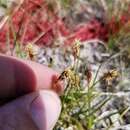Comprehensive Description
provided by North American Flora
Carex heliophila Mackenzie, Torreya 13: 15. 1913
Carex pennsylvanica var. digyna Bock. Linnaea 41: 220. 1S77. (Type from Saskatchewan.) "Carex pennsylvanica Lam." Mackenzie & Bush, Man. Fl. Jackson Co. 50. 1902. "Carex pennsylvanica var. vesperlina L. H. Bailey" Holm, in Rydb. Fl. Colo. 73. 1906. Carex pennsylvanica var. pinicola M. E. Jones, Bull. Univ. Mont. 61: 21. 1910. (Type from Alta, Montana.)
In small to medium-sized clumps, from slender but tough rootstocks, sending forth long, slender horizontal stolons, the culms 0.5-3.5 dm. high, exceeding all or most of the leaves, slender but stiff, wir and erect, rough on the angles above, phyllopodic, reddish-brown-tinged and usually strongly fibriUose at base, and clothed with the dried-up leaves of the previous year; sterile shoots phyllopodic; leaves with well-developed blades 5-10 to a fertile culm, the blades erect, thin but firm and stiff, dull-green, chatmeled towards base, 4-20 cm. long, 1-2.5 mm. wide, attenuate, much roughened, the margins slightly revolute, the lower sheaths often breaking and becoming filamentose, the ligule much wider than long; terminal spike staminate or occasionally with a few perigynia towards ape.x, S-20 mm. long, 3-6 mm. wide, more or less peduncled, many-flowered, the scales oblong-obovate, the lower obtusish to acute or short cuspidate, the uppermost loose, narrow and conspicuously cuspidate and forming a short cone, reddish-brown with lighter center and more or less conspicuous white-hyaline margins; pistillate spikes I or 2, or rarely 3, from contiguous to more or less strongly separate, suborbicular and sessile or nearly so, 4-6 mm. long, closely flowered, the perigynia 5-15, ascending in several rows; lowest bract not sheathing, squamiform or occasionally green and prolonged, but shorter than culm, reddish-brown-tinged at base, the upper much reduced; scales ovate, obtuse to strongly cuspidate, usually acute or short-cuspidate, reddish-brown or tawny-tinged with lighter 1-3 nerved center and white-hyaline sides (but scarcely apex), from slightly longer to slightly shorter than, but not enveloping or concealing perigynia; perigynia 3.5 mm. long, the body puberulent or short-pubescent, dull-green, membranaceous, short-oval, 2.25-2.75 mm. long, 2-2.25 mm. wide, 2-keeled, otherwise nerveless, suborbicular in cross-section, abruptly strongly stipitate (the stipe 0.5 mm. long), spongy at base, abruptly contracted into a beak 0.75 mm. long, serrulate, strongly bidentate, the teeth slender; achenes triangular, with strongly convex sides and sharp angles, closely enveloped by perigynium, 2 mm. long, 1.75-2 mm. wide, round-tapering at base, substipitate, rounded at apex and minutely apiculate, jointed with the slender style, scarcely enlarged at base; stigmas three, slender, reddish-brown.
Type locality: Lee's Summit. Jackson County, Missouri {Mackenzie).
Distribution: Prairies and plains in calcareous districts, Manitoba to Alberta, and southward to Illinois, Missouri, and New Mexico. (Specimens examined from Manitoba, Minnesota, Illinois, Iowa, Missouri, Saskatchewan, North Dakota, South Dakota, Nebraska, Kansas, Alberta, Wyoming. Colorado, New Mexico.)
- bibliographic citation
- Kenneth Kent Mackenzie. 1935. (POALES); CYPERACEAE; CARICEAE. North American flora. vol 18(4). New York Botanical Garden, New York, NY

